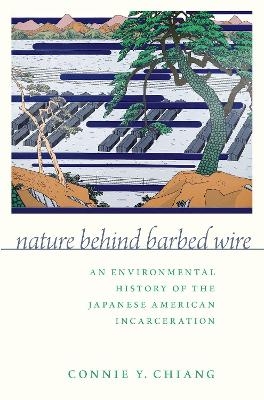
Nature Behind Barbed Wire
An Environmental History of the Japanese American Incarceration
Seiten
2020
Oxford University Press Inc (Verlag)
978-0-19-753356-7 (ISBN)
Oxford University Press Inc (Verlag)
978-0-19-753356-7 (ISBN)
Nature Behind Barbed Wire uses an environmental lens to reinterpret the forced removal and confinement of Japanese Americans during World War II.
The mass imprisonment of over 110,000 people of Japanese ancestry during World War II was one of the most egregious violations of civil liberties in United States history. Removed from their homes on the temperate Pacific Coast, Japanese Americans spent the war years in desolate camps in the nation's interior. Photographers including Ansel Adams and Dorothea Lange visually captured these camps in images that depicted the environment as a source of both hope and hardship. And yet the literature on incarceration has most often focused on the legal and citizenship statuses of the incarcerees, their political struggles with the US government, and their oral testimony.
Nature Behind Barbed Wire shifts the focus to the environment. It explores how the landscape shaped the experiences of both Japanese Americans and federal officials who worked for the War Relocation Authority (WRA), the civilian agency that administered the camps. The complexities of the natural world both enhanced and constrained the WRA's power and provided Japanese Americans with opportunities to redefine the terms and conditions of their confinement. Even as the environment compounded their feelings of despair and outrage, the incarcerees also found that their agency in transforming and adapting to the natural world could help them survive and contest their incarceration. Japanese Americans and WRA officials negotiated the terms of confinement with each other and with a dynamic natural world.
Ultimately, as Connie Chiang demonstrates, the Japanese American incarceration was fundamentally an environmental story.
The mass imprisonment of over 110,000 people of Japanese ancestry during World War II was one of the most egregious violations of civil liberties in United States history. Removed from their homes on the temperate Pacific Coast, Japanese Americans spent the war years in desolate camps in the nation's interior. Photographers including Ansel Adams and Dorothea Lange visually captured these camps in images that depicted the environment as a source of both hope and hardship. And yet the literature on incarceration has most often focused on the legal and citizenship statuses of the incarcerees, their political struggles with the US government, and their oral testimony.
Nature Behind Barbed Wire shifts the focus to the environment. It explores how the landscape shaped the experiences of both Japanese Americans and federal officials who worked for the War Relocation Authority (WRA), the civilian agency that administered the camps. The complexities of the natural world both enhanced and constrained the WRA's power and provided Japanese Americans with opportunities to redefine the terms and conditions of their confinement. Even as the environment compounded their feelings of despair and outrage, the incarcerees also found that their agency in transforming and adapting to the natural world could help them survive and contest their incarceration. Japanese Americans and WRA officials negotiated the terms of confinement with each other and with a dynamic natural world.
Ultimately, as Connie Chiang demonstrates, the Japanese American incarceration was fundamentally an environmental story.
Connie Y. Chiang is Professor of History and Environmental Studies at Bowdoin College. She is the author of Shaping the Shoreline: Fisheries and Tourism on the Monterey Coast.
Acknowledgments
Note on Terminology
Introduction: The Nature of Confinement
Chapter 1: Removal and Displacement
Chapter 2: Choosing Sites, Building Camps
Chapter 3: Maintaining the Camps
Chapter 4: Desert Agriculture
Chapter 5: Environmental Patriotism
Chapter 6: Outdoor Recreation
Chapter 7: Dispersal, Resettlement, Return
Epilogue: Emanating from the Soil
Notes
Selected Bibliography
Index
| Erscheinungsdatum | 02.09.2020 |
|---|---|
| Zusatzinfo | 34 halftones |
| Verlagsort | New York |
| Sprache | englisch |
| Maße | 157 x 234 mm |
| Gewicht | 476 g |
| Themenwelt | Sachbuch/Ratgeber ► Geschichte / Politik ► Allgemeines / Lexika |
| Geschichte ► Allgemeine Geschichte ► 1918 bis 1945 | |
| Geisteswissenschaften ► Geschichte ► Regional- / Ländergeschichte | |
| Geschichte ► Teilgebiete der Geschichte ► Militärgeschichte | |
| Weitere Fachgebiete ► Land- / Forstwirtschaft / Fischerei | |
| ISBN-10 | 0-19-753356-6 / 0197533566 |
| ISBN-13 | 978-0-19-753356-7 / 9780197533567 |
| Zustand | Neuware |
| Haben Sie eine Frage zum Produkt? |
Mehr entdecken
aus dem Bereich
aus dem Bereich
ein Psychologe erlebt das Konzentrationslager
Buch | Hardcover (2024)
Kösel (Verlag)
CHF 30,80
Mythos „Stauffenberg-Attentat“ – wie der 20. Juli 1944 verklärt und …
Buch | Hardcover (2024)
Goldmann (Verlag)
CHF 33,55


